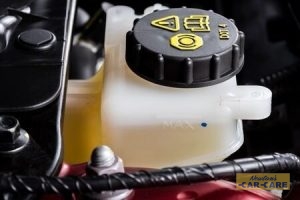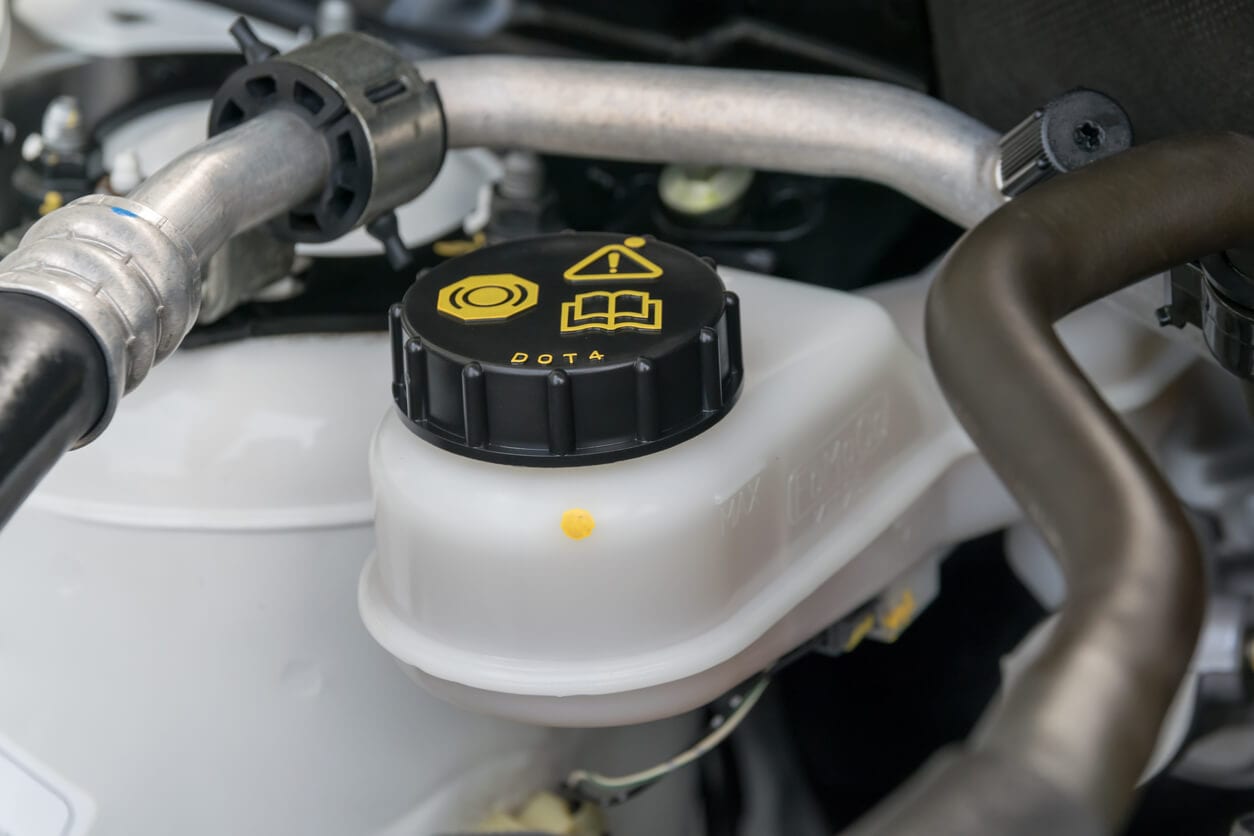How to Know If Brake Fluid is Low
To know if brake fluid is low, check the fluid level in the reservoir. If it is below the minimum mark, the brake fluid is low.
Maintaining the proper level of brake fluid in your vehicle is crucial for the optimal performance of your braking system. Neglecting to monitor and replenish low brake fluid levels can lead to decreased braking capability and potential safety hazards on the road.
We will discuss the importance of brake fluid, signs of low brake fluid, and steps to take if you suspect your brake fluid is low. By understanding the indicators and taking appropriate action, you can ensure your vehicle’s brakes operate effectively and keep you safe while driving.

Credit: www.newtonscarcare.com
Signs Of Low Brake Fluid
It’s crucial to identify the signs of low brake fluid to ensure the safety and performance of your vehicle. Low brake fluid can lead to compromised braking ability and should be addressed promptly. Keep an eye out for the following indicators to determine if your brake fluid is running low:
Dashboard Warning Light
When the brake fluid is low, a dashboard warning light will illuminate. This indicator serves as an early alert to check and refill the brake fluid level. Ignoring this warning can result in unsafe driving conditions.
Spongy Brake Pedal
A spongy or soft brake pedal is a common symptom of low brake fluid. If you notice that the brake pedal feels less firm or requires more pressure to function effectively, it’s a strong indication that the brake fluid may be low and needs attention.
Reduced Braking Power
Low brake fluid can lead to reduced braking power, causing longer stopping distances and less effective braking overall. If you experience an increase in the distance required to stop your vehicle, it’s important to check the brake fluid level as soon as possible.

Credit: www.sunautoservice.com
Causes Of Low Brake Fluid
Leaking Brake System
Leaking brake system results in low brake fluid.
Worn Brake Pads
Worn brake pads lead to low brake fluid level.
Brake Caliper Issues
Brake caliper issues can cause low brake fluid.
Checking Brake Fluid Level
Checking Brake Fluid Level:
Locating The Brake Fluid Reservoir
Under the hood, find the brake fluid reservoir near the back of the engine compartment.
It is typically a small, translucent plastic container with a cap labeled “brake fluid.”
Inspecting The Brake Fluid Level
- Once locating the reservoir, visually inspect the fluid level against the markings on the side.
- If the fluid level is below the “minimum” mark, it indicates low brake fluid.
- Ensure the cap is secure before checking the level to prevent contamination.
- Also, make sure the car is on a level surface for an accurate reading.
Steps To Top Up Brake Fluid
When it comes to maintaining your vehicle’s safety, checking the brake fluid level is crucial. Low brake fluid can affect the performance of your brakes, potentially putting you and your passengers at risk. Here are the steps to top up brake fluid, along with the necessary tools and materials to gather for this task.
Gathering The Necessary Tools And Materials
Before starting the process of topping up the brake fluid, it’s important to gather the required tools and materials. Check to ensure you have the following items on hand:
- Brake Fluid: Verify the type of brake fluid recommended for your vehicle and purchase the appropriate amount if needed.
- Lint-Free Cloth: This will be used to clean the brake fluid reservoir and cap to prevent any contaminants from entering the system.
- Turkey Baster or Syringe: To remove any excess brake fluid from the reservoir, if necessary.
- Owner’s Manual: Refer to the manual for specific instructions and safety precautions related to your vehicle’s brake system.
- Protective Gloves: To shield your hands from contact with the brake fluid, which can be corrosive.
Removing The Brake Fluid Reservoir Cap
Once you have the necessary tools and materials assembled, it’s time to proceed with topping up the brake fluid. Start by locating the brake fluid reservoir, typically situated near the vehicle’s firewall. Follow these simple steps to remove the reservoir cap:
- Locate the Reservoir: Identify the brake fluid reservoir under the hood. It is usually a transparent or semi-transparent container with minimum and maximum level markings.
- Clean the Area: Before opening the reservoir, wipe any dirt or debris from the top of the reservoir cap using a clean, lint-free cloth to prevent contamination of the brake system.
- Unscrew the Cap: Twist the cap counterclockwise to remove it, ensuring it is fully removed to allow for easy access when adding the brake fluid.
Adding Brake Fluid
Now that the reservoir cap is off, it is time to add brake fluid to bring the level back to the appropriate range. Follow these steps to successfully add brake fluid to your vehicle:
- Check the Level: Inspect the current level of the brake fluid in the reservoir. If it is below the minimum level, proceed with adding more fluid.
- Pouring the Fluid: Slowly pour the brake fluid into the reservoir, using a funnel if necessary to prevent spillage. Be mindful not to overfill, as this can lead to brake system malfunctions.
- Secure the Cap: After adding the brake fluid, securely fasten the reservoir cap by twisting it clockwise until it is snug. It should be tightly sealed to prevent any leakage.
Seeking Professional Help
If you’re unsure about your brake fluid levels, seeking professional help is the best way to know for sure. An expert will be able to assess the situation and advise on any necessary action.
Identifying Complex Brake Issues
If you’re experiencing brake problems that go beyond low brake fluid, it may be time to seek professional help. Identifying complex brake issues requires expertise and specialized equipment that only a qualified mechanic can provide.
Here are a few signs that indicate a complex brake issue:
- Unusual noises: If your brakes make grinding, squealing, or clicking noises, it could be a sign of worn brake pads, a damaged rotor, or another issue affecting your braking system.
- Pull or vibration: If your vehicle pulls to one side when braking or you notice a noticeable vibration in the brake pedal, it could be a sign of uneven brake pad wear, a warped rotor, or a problem with the brake calipers.
- Soft or spongy pedal: If your brake pedal feels soft or spongy and requires excessive pressure to engage, there may be air in the brake lines, a worn master cylinder, or another issue affecting the hydraulic system.
- Warning lights: If your vehicle’s dashboard warning lights, such as the ABS (Anti-lock Braking System) or brake warning light, are illuminated, it’s crucial to have a mechanic diagnose the problem as soon as possible.
When To Consult A Mechanic
If you encounter any of the above signs or suspect a more complex brake issue, it’s essential to consult a qualified mechanic. Delaying professional assistance can lead to further damage, compromised safety, or even brake failure.
When it comes to brake problems, it’s always better to be safe than sorry. Seeking the help of a mechanic can provide the following benefits:
- Expertise: Mechanics undergo extensive training and have the knowledge to diagnose and repair brake issues accurately.
- Proper equipment: Mechanics have access to specialized tools and equipment to diagnose and fix complex brake problems effectively.
- Warranty protection: Professional mechanics often provide warranties for their services, giving you peace of mind that any issues will be resolved efficiently.
Ultimately, always remember that your safety and the safety of others on the road should never be compromised. If you’re unsure about the severity of your brake problem or lack the necessary tools and expertise, consulting a mechanic is the best course of action.
Credit: www.quora.com
Frequently Asked Questions On How To Know If Brake Fluid Is Low
How Do I Know If My Car Needs Brake Fluid?
Check the brake fluid reservoir for the level. If it’s below the recommended mark, your car may need brake fluid. Observe for any leaks under the car or a soft brake pedal, as these could also indicate low brake fluid.
What Happens If You Run Low On Brake Fluid?
Low brake fluid can cause decreased braking performance and potential safety hazards. It’s crucial to top up the fluid immediately.
How Do You Check Brake Fluid Level?
To check brake fluid level, locate reservoir, ensure level is between min and max markings. Top up if low.
How Do Brakes Feel When Fluid Is Low?
When brake fluid is low, brakes may feel spongy or soft, requiring more pressure to stop the vehicle. This can lead to decreased braking performance and potential safety risks. Regularly check brake fluid levels and address any issues promptly to ensure proper braking function.
How Do I Check If My Brake Fluid Is Low?
You can check the brake fluid level by locating the brake fluid reservoir and visually inspecting the fluid level against the “minimum” or “low” mark.
Why Is Low Brake Fluid Dangerous?
Low brake fluid can result in reduced braking power, longer stopping distances, and potential brake failure in extreme cases. It is essential to maintain the proper fluid level for optimal braking performance.
What Are The Signs Of Low Brake Fluid?
Signs of low brake fluid include a soft brake pedal, illuminated warning light on the dashboard, longer brake pedal travel, and a spongy or unresponsive brake feel.
Conclusion
In a nutshell, keeping your brake fluid at the right level is crucial for safe driving. By recognizing the signs of low brake fluid, you can prevent potential hazards. Regularly check and maintain your brake fluid to ensure optimal vehicle performance and safety on the road.
Stay vigilant and act promptly.
